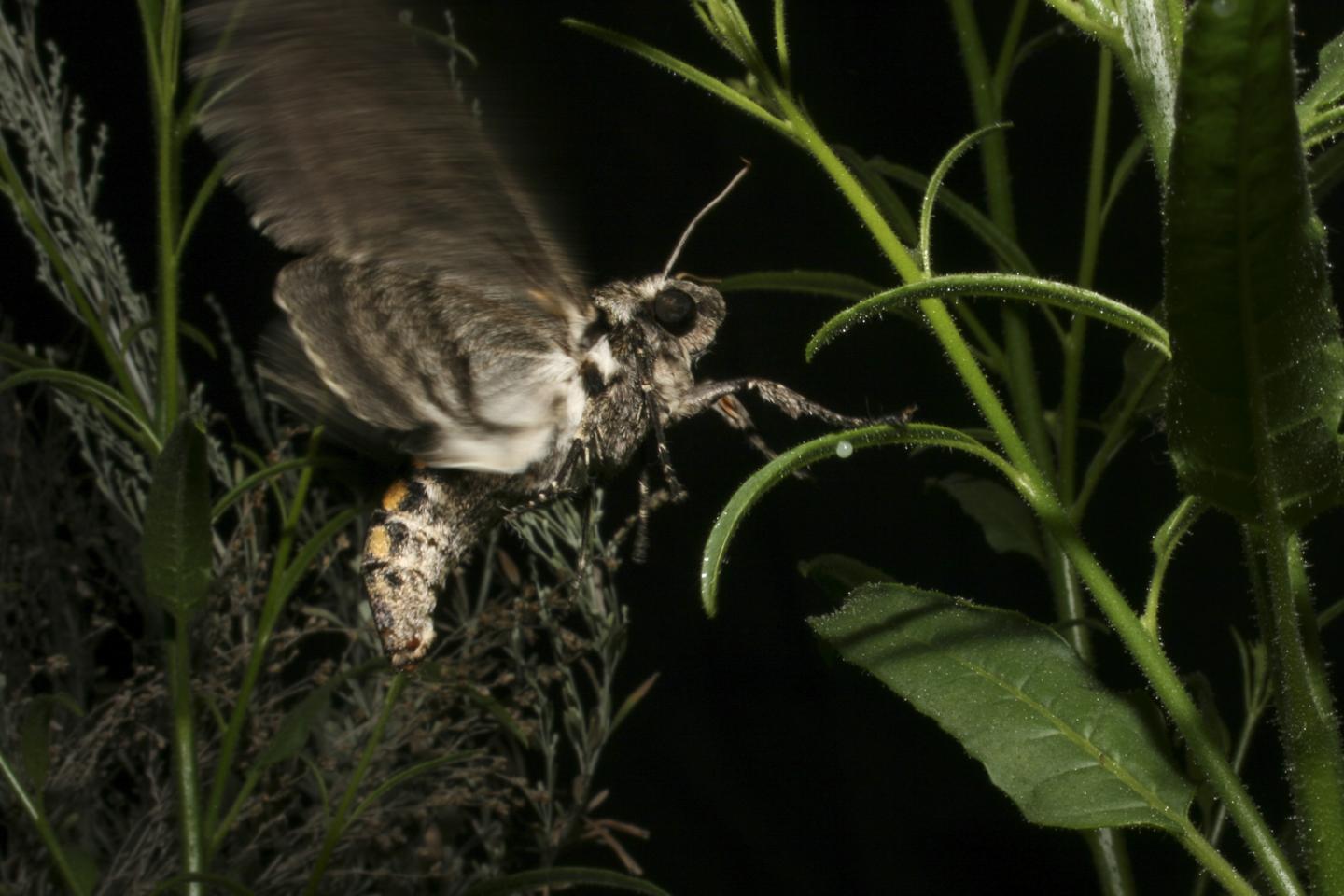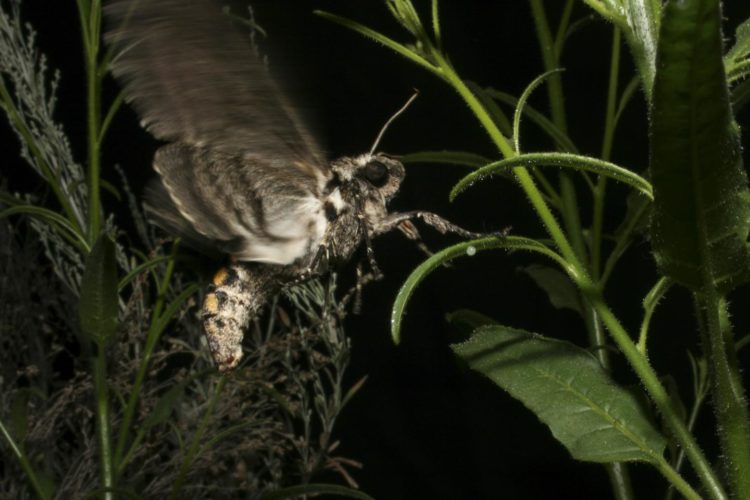An olfactory co-receptor allows moths to avoid intraspecific competition

Credit: Danny Kessler, Max Planck Institute for Chemical Ecology
Ovipositing insects use odor cues to select suitable food substrates for their offspring in order to increase the survival rates of the larvae. Scientists from the Max Planck Institute for Chemical Ecology demonstrated that not only may plant odors determine the best oviposition site, but also the frass of other larvae of the same species. They specified the repelling substance in the feces of tobacco hornworm larvae which signals the presence of competing conspecifics to the female moths. Moreover, the researchers were able to identify an odorant receptor which is involved in the detection of the typical smell of larval frass and thereby governs competition avoidance during oviposition (Proceedings of the National Academy of Sciences of the United States of America, October 2019, DOI: 10.1073/pnas.1913485116 PNAS).
Very hungry caterpillars
Tobacco hornworms (Manduca sexta) are extremely voracious. Their Latin name Manduca is derived from the verb manducare, which means eating or chewing. These insatiable caterpillars, which may become as big as an adult’s finger, do not do anything but eat and chew all day long. Therefore, a single larva is able to defoliate a host plant, such as the wild tobacco Nicotiana attenuata or sacred datura Datura wrightii (at least small plants) completely. Hence, one plant is seldom enough to feed a second caterpillar.
“We knew already that moths select their oviposition sites carefully. So far we and others basically focused on the idea that the moths detect changes in the odor profiles of plants that have already been attacked by caterpillars and therefore lay their eggs somewhere else. We were interested in whether moths also consider information that is provided by the larvae, i.e. by the potential competitors of the moths’ offspring, directly,” explains Markus Knaden, one of the main authors of the publication.
It seemed plausible that tobacco hawkmoths would try to avoid competition for their offspring. Nevertheless, that one specific class of volatile compounds in the larval feces (6-carbon aliphatic acids) would be sufficient to trigger avoidance behavior came as a surprise. Behavioral assays in the wind tunnel in which moths were exposed to individual odor components on filter paper clearly showed that moths were repelled by some of the frass-related compounds.
In ovipositing moths, the receptor IR8a regulates the avoidance of larval frass
This specificity in the avoidance response to 6-carbon aliphatic acids allowed the scientists to elucidate the molecular basis of the behavior. By using the novel technique CRISPR/Cas9, they knocked out specific receptor proteins in the antennae, the moth’s nose, that were crucial for the detection of these compounds, and were thus able to show that the ionotropic receptor 8a (IR8a) governs the avoidance response to larval feces.
“Surprisingly, so far no one has investigated how moths detect signals from larval frass. Our experiments with moths which lacked IR8a proteins demonstrated that without these proteins, ovipositing moths were unable to detect and avoid conspecific competitors and laid their eggs at places where the chances for their offspring were diminished. Our study shows for the first time that the IR8a pathway is essential for mediating acid avoidance caused by caterpillar feces,” summarizes Jin Zhang from China, who is first author of the study and whose research project at the Max Planck Institute for Chemical Ecology was supported by the Alexander von Humboldt Foundation.
Evolutionary context and perspective
Plant-insect interactions are diverse and highly complex. They have evolved over the course of evolution and can be adapted whenever a parameter changes. It is not a new discovery that tobacco hawkmoths lay significantly fewer eggs on plants that are already being attacked by caterpillars. In addition, the smell of larval feces is known to attract predators, the enemies of the larvae. However, it was not known that the same larval frass ensures that conspecifics which would otherwise compete for food are kept at a distance. Thus, the chemical signal from the frass helps not only the caterpillars which are already feeding on a plant but also the hovering moths: By avoiding the smell of larval feces, they may find better food for their offspring.
The recently developed genetic tools provide new opportunities to study odor-guided behavior in Manduca sexta and other pest insects in more detail. Researchers are particularly interested in addressing the following questions: Which factors, such as flower scents, humidity and CO2, guide insects to their host plants? Which receptor proteins regulate responses to specific odors? What genes are involved in these particular behaviors?
Fundamental knowledge gained from these studies may help to better prepare us for the agricultural challenges resulting from climate change. [AO/KG]
###
Original Publication:
Zhang, J., Bisch-Knaden, S., Fandino, R. A., Yan, S., Obiero, G. F., Grosse-Wilde, E., Hansson, B. S., Knaden, M. (2019). The olfactory co-receptor IR8a governs larval feces-mediated competition avoidance in a hawkmoth. Proceedings of the National Academy of Sciences of the United States of America, DOI: 10.1073/pnas.1913485116
https:/
Further Information:
Jin Zhang, Ph.D., Max Planck Institute for Chemical Ecology, Hans-Knöll-Str. 8, 07745 Jena, Tel. +49 3641 57 1413, E-Mail: [email protected]
Dr. Markus Knaden, Max Planck Institute for Chemical Ecology, Hans-Knöll-Str. 8, 07745 Jena, Tel. +49 3641 57 1421, E-Mail: [email protected]
Contact and Media Requests:
Angela Overmeyer M.A., Max-Planck-Institut für chemische Ökologie, Hans-Knöll-Str. 8, 07745 Jena, +49 3641 57-2110, E-Mail [email protected]
Download of high resolution images and videos via http://www.
Media Contact
Markus Knaden
[email protected]
49-364-157-1421
Original Source
http://www.
Related Journal Article
http://dx.





